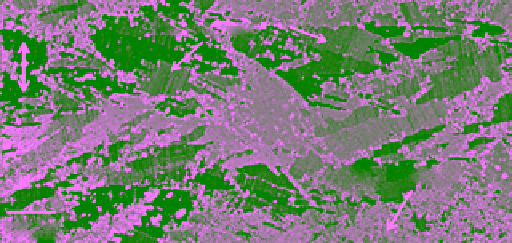Geology Reference
In-Depth Information
(a)
(b)
1mm
1mm
Figure 2.31
Thermally etched surface of biaxially deformed sea ice exhibiting tilt boundaries, cells, and grain/
subgrain boundaries at a junction of several grains with different orientations of c‐axis (a) and polygonized area
inside one grain (b) (Micrograph by N. K. Sinha, unpublished).
and Crocker
[1988] reported snow base salinities up to
80‰ in the Labrador Sea ice. They suggested the idea of
“wicking up” brine by snow from the highly saline thin
ice surface though capillary action. When frost flowers
grow on the surface of thin ice (section 9.4), they usually
wick up brine from the surface, and therefore have
extremely high salinity that can reach 100‰ or more
[
Martin et al
., 1995].
Boxe and Saiz‐Lopez
[2009] discussed
the effect of brine layers at the snow/ice interface on the
polar environment and its effect on the trace gases within
the snowpack and into the atmosphere, in particular.
Tilt boundaries
Polygonized
10 mm
Figure 2.32
Biaxially confined, deformed S3‐type sea ice
exhibiting “small‐angle tilt boundaries” and polygonized ice
under cross‐polarized light; double arrow indicates the direc-
tion of water current under the ice sheet as well as the average
c‐axis of the grains (Photo by N. K. Sinha, unpublished).
Gravity Drainage
The third mechanism for bulk desalination is the grav-
ity drainage. This is the prime desalination mechanism
of sea ice where the greater weight of the brine relative
to that of the seawater tends to drive the brine out of the
ice‐water interface. Once the sea ice thickness exceeds 50
or 100 mm, a network of so‐called brine drainage chan-
nels with their tributaries is formed. These are vertical
or near‐vertical conduits through which plumes of brine
drain into the underlying seawater. Hence, gravity drain-
age requires the presence of a fairly dense interconnected
network of brine channels with their tributaries in order
to carry brine by gravity action.
The existence of this network was observed and
described in
Lake and Lewis
[1970]. They concluded
that horizontal migration of brine toward preferred
Going back to the topic of brine migration, it is appro-
priate to mention that relatively high salinities are com-
monly observed at the surfaces of thin ice covers and at
the base of the snowpack. The presence of high salinity
can be tasted readily, and naturally this is a common
knowledge among the Inuit people of the north.
Martin
[1979] reported surface salinities as high as 95‰ from
newly formed sea ice in the Beaufort Sea. Sublimation
from the surfaces layers is certainly one of the mecha-
nisms responsible for salt concentration at the top.
Another mechanism is the brine migration to the surface
from the layers immediately below the surface.
Drinkwater


